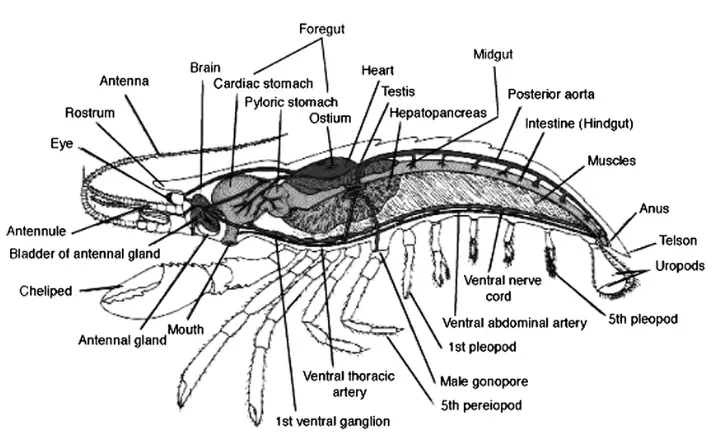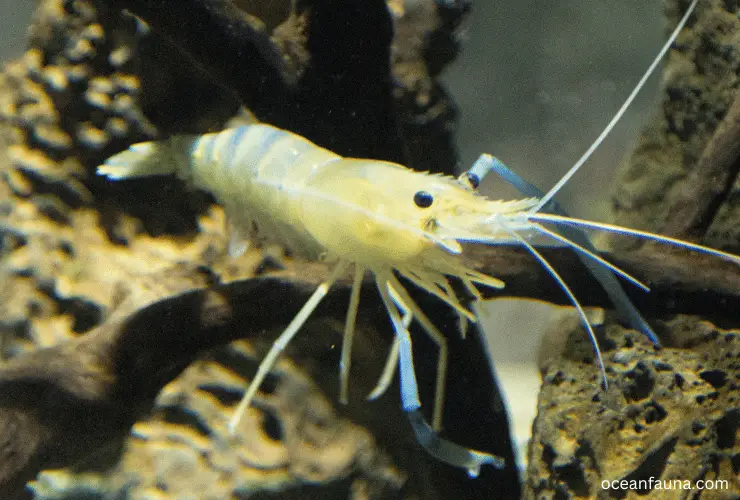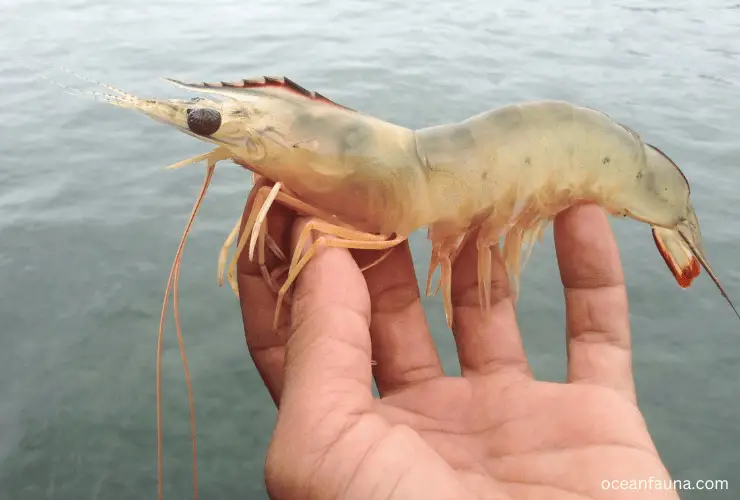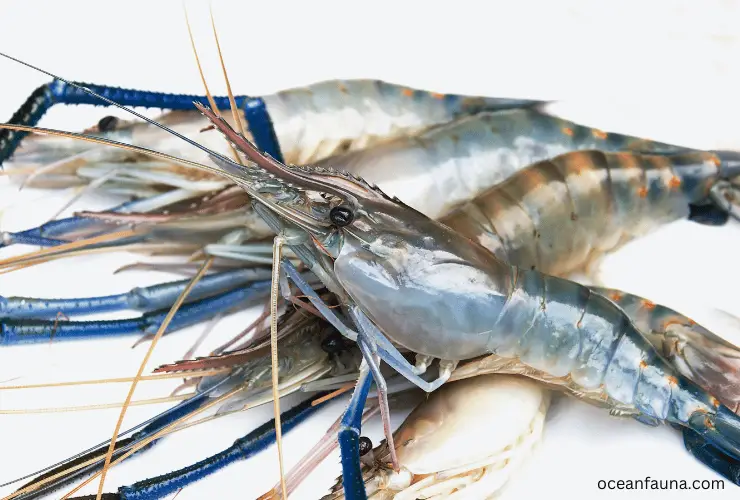Shrimp are a type of crustacean that belong to the same family as crabs, lobsters, and crayfish. These small, often pinkish-colored creatures can be found worldwide in saltwater and freshwater environments.
Yes, Shrimp do have brains, albeit small ones. The nervous system of a shrimp is comprised of a chain of ganglia, which are clusters of nerve cells that control different parts of the body. Shrimp have a highly specialized anatomy that allows them to navigate their environment, avoid predators, and find food. And they’re capable of learning and have a memory as well. While their cognitive abilities may not be as advanced as those of some other animals, Shrimp have evolved a highly specialized nervous system that allows them to thrive in their marine environment.
While Shrimp may not be the first animal that comes to mind when you think of intelligence, you may still wonder if they have brains at all. In this article, we will explore the anatomy and behavior of Shrimp to answer the question: do shrimp have brains?
Shrimp Anatomy and Nervous System
Shrimp are fascinating creatures belonging to the crustaceans family. These tiny creatures are found in almost every aquatic ecosystem and play a significant role in the food chain.

Shrimp anatomy and nervous system are two critical components that help them survive in their habitat.
Anatomy of Shrimp
Shrimp have an elongated body divided into two main sections – the cephalothorax and the abdomen. The cephalothorax consists of the head and thorax, while the abdomen is made up of several segments.
On top of that, they have a hard exoskeleton that protects their body from predators and gives them structural support. The exoskeleton is made up of chitin, a tough and fibrous material found in other crustaceans’ shells.
The head of a shrimp contains its brain, eyes, antennae, and mouthparts. The brain is small and located in the dorsal region of the head. The eyes are compound and located on the sides of the head. They are made up of several small lenses that allow the Shrimp to see in different directions.
The antennae are sensory organs that help the Shrimp detect its environment, locate food, and avoid predators. The mouthparts are located on the underside of the head and are used for feeding.
Why is the heart of a shrimp located in its head
Shrimp have tube-like and simple structured hearts which are located near the top part of their head. The heart of shrimp, like any other animal and humans, pumps blood through the body.
Since the heart is located near the head, it increases efficiency as it takes less time for blood to reach the brain and other important organs. Moreover, this placement of heart near the head helps shrimp to maintain efficient body-shape which helps them to swim in water.
Nervous System of Shrimp
Shrimp have a nervous system that allows them to respond quickly to their environment. The nervous system consists of a brain, nerve cords, and sensory receptors.
The brain of a shrimp is small, but it is highly specialized and capable of processing a wide range of sensory information. The brain is connected to a pair of nerve cords that run the length of the Shrimp’s body. These nerve cords control the movement of the Shrimp’s appendages and transmit sensory information to the brain.
Shrimp have several sensory receptors that allow them to detect environmental changes. These receptors include chemoreceptors, mechanoreceptors, and photoreceptors.
Do Shrimp Have Brains?
The answer is yes; Shrimp do have brains. But they are not organized like a human or other vertebrate animal’s brain.

Shrimp have what is known as a decentralized nervous system, which means that their nervous system is spread throughout their body and not centralized in one area. While Shrimp do have a group of nerve cells that act as a brain, it is much less complex than the brain of a mammal or bird.
The Shrimp’s brain is located in its head and is made up of several ganglia, or groups of nerve cells. These ganglia are connected to each other and to the rest of the Shrimp’s nervous system by nerve fibers. The Shrimp’s brain is responsible for processing information from its senses, controlling its movements, and coordinating its behavior.
However, because the Shrimp’s brain is less centralized than a vertebrate’s brain, it may be less efficient at processing information. It may not be capable of complex cognitive processes like learning or memory.
Despite their relatively simple nervous system, Shrimp is still capable of displaying a variety of behaviors that suggest some level of intelligence. For example, Shrimp are known to engage in complex social behaviors, such as forming hierarchies and communicating with each other through chemical signals. They can also navigate their environment and avoid predators, suggesting they can process sensory information and respond to their surroundings.
Shrimp Behavior and Intelligence
Shrimp are fascinating creatures widely known for their delicious taste and nutritional value.
However, many people are unaware of these small crustaceans’ intriguing behavior and intelligence.
So let’s explore the behavior and intelligence of Shrimp and how they interact with their environment and each other.
Behavior of Shrimp
Shrimp are social creatures that live in large groups or colonies. They have a complex social hierarchy, where the dominant Shrimp have access to the best resources, such as food and mates. Several factors, such as the presence of predators, availability of food, and mating opportunities, influence the behavior of Shrimp.

Shrimp are active during the day and night and can be seen scavenging for food on the ocean floor. They use their pincers to grab and manipulate their prey and their antennae to sense their environment.
Shrimp are also known for their impressive swimming skills, which they use to escape from predators or move to new locations.
Shrimp have several defensive mechanisms to protect themselves from predators. They can camouflage themselves to blend in with their environment, release a cloud of ink to confuse predators or shed their exoskeleton to escape from tight spaces.
Shrimp also has a unique ability to regenerate lost limbs, which helps them recover from injuries quickly.
Intelligence of Shrimp
Although shrimp are small in size, they have surprising intelligence that allows them to navigate their environment and interact with other Shrimp. Shrimp are capable of learning and memory, and they can recognize and remember their social partners, predators, and food sources.
Shrimp have a well-developed nervous system that allows them to respond quickly to changes in their environment. They can detect changes in water temperature, salinity, and chemical composition, which helps them navigate to suitable habitats.
Besides, Shrimp are also capable of complex decision-making, such as choosing between different food sources or mates based on their quality.
Additionally, they have the capability of social learning, which means that they can learn from observing the behavior of other Shrimp. For example, if a dominant shrimp finds a new food source, other Shrimp will observe and learn from its behavior. Soon the entire colony will start scavenging from the same source.
Shrimp Sensory Processing and Navigation
Shrimp have a variety of sensory systems that they use for processing information and navigation. Their most important sensory systems are vision, chemoreception, and mechanoreception.
Vision plays a critical role in shrimp navigation. Shrimp have compound eyes comprising thousands of individual lenses, each with its own photoreceptor. These eyes allow shrimp to detect changes in light intensity and color, which they use to navigate and avoid predators.

Chemoreception is also important for Shrimp, as they use chemical signals to communicate with other Shrimp and to detect predators and prey. Shrimp have specialized chemoreceptors located on their antennae and other body parts that allow them to detect chemicals in the water.
Mechanoreception, or the ability to sense touch and pressure, is another important sensory system for Shrimp. They use this sense to detect vibrations in the water, which can help them locate nearby predators and prey.
Shrimp combines these sensory systems to navigate their environment and locate food while avoiding predators.
Comparative Analysis of Shrimp and Human Brain
Shrimp and human brains differ significantly in size and complexity. Shrimp have very small brains that are significantly less complex than those of humans.
Shrimp have a brain that is divided into three main parts: the protocerebrum, deutocerebrum, and tritocerebrum. The protocerebrum controls vision and visual information processing, while the deutocerebrum is responsible for chemoreception and chemical information processing. The tritocerebrum controls motor functions, such as movement and feeding.
Additionally, the comparison of shrimp and human brains is complex, and the table only highlights a few key differences between the two.
| Criteria | Shrimp Brain | Human Brain |
| Size | Small, approximately the size of a grain of rice | Large, approximately 1.4 kg |
| Neuron Count | Approximately 100,000 | Approximately 100 billion |
| Complexities | The shrimp brain is relatively simple, with basic sensory processing, learning, and memory functions | The human brain is highly complex and capable of advanced cognitive functions, including language, abstract thinking, and problem-solving |
| Regions | The shrimp brain has several distinct regions, including the optic ganglia, antennal lobes, and the central brain | The human brain has several distinct regions, including the cerebrum, cerebellum, and brainstem |
| Nervous System | Shrimp have a decentralized nervous system, with ganglia (clusters of neurons) distributed throughout their body | Humans have a centralized nervous system, with the brain and spinal cord serving as the control center |
| Intelligence | Shrimp are capable of basic learning and memory functions, but their intelligence is limited compared to humans | Humans have a high level of intelligence, with the ability to engage in complex problem-solving, decision-making, and creative thinking |
In summary, while both Shrimp and humans have brains and rely on them for sensory processing and navigation, the brains of humans are significantly larger, more complex, and more advanced compared to those of Shrimp.
FAQs
How big are shrimp brains?
Ans: Shrimp brains are very small, typically only a few millimeters in size. However, their size is proportional to the size of the Shrimp’s body.
Are shrimp brains less complex than human brains?
Ans: Yes, shrimp brains are less complex than human brains. While they have specialized regions that process sensory information and control movement, their brains are much simpler in structure. They have fewer neurons than the human brain.
Do Shrimp have emotions or feelings?
Ans: It is not clear whether Shrimp have emotions or feelings, as they lack the advanced brain structures and neural pathways associated with complex emotions in humans. However, some studies have suggested that Shrimp may exhibit certain behaviors that could be interpreted as signs of stress or pain.
Can shrimp learn and Remember things?
Ans: Yes, Shrimp can learn and remember information to some extent. They have been shown to exhibit various behaviors, such as associative learning, that suggest they can learn and retain information. However, their cognitive abilities are limited compared to those of humans.
Conclusion
In conclusion, while Shrimp may not have brains as complex as those of vertebrate animals, they have a decentralized nervous system. And it allows them to process information, control their movements, and exhibit complex behaviors.


1 thought on “Do Shrimp Have Brains? [Scientifically Explained]”